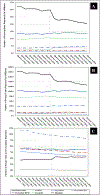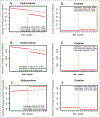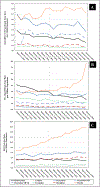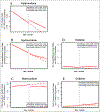The impact of hydrocodone rescheduling on utilization, abuse, misuse, and overdose deaths
- PMID: 36779261
- PMCID: PMC10257747
- DOI: 10.1002/pds.5603
The impact of hydrocodone rescheduling on utilization, abuse, misuse, and overdose deaths
Abstract
Purpose: To evaluate the impact of increased federal restrictions on hydrocodone combination product (HCP) utilization, misuse, abuse, and overdose death.
Methods: We assessed utilization, misuse, abuse, and overdose death trends involving hydrocodone versus select opioid analgesics (OAs) and heroin using descriptive and interrupted time-series (ITS) analyses during the nine quarters before and after the October 2014 rescheduling of HCPs from a less restrictive (CIII) to more restrictive (CII) category.
Results: Hydrocodone dispensing declined >30% over the study period, and declines accelerated after rescheduling. ITS analyses showed that immediately postrescheduling, quarterly hydrocodone dispensing decreased by 177M dosage units while codeine, oxycodone, and morphine dispensing increased by 49M, 62M, and 4M dosage units, respectively. Postrescheduling, hydrocodone-involved misuse/abuse poison center (PC) case rates had a statistically significant immediate drop but a deceleration of preperiod declines. There were small level increases in codeine-involved PC misuse/abuse and overdose death rates immediately after HCP's rescheduling, but these were smaller than level decreases in rates for hydrocodone. Heroin-involved PC case rates and overdose death rates increased across the study period, with exponential increases in PC case rates beginning 2015.
Conclusions: HCP rescheduling was associated with accelerated declines in hydrocodone dispensing, only partially offset by smaller increases in codeine, oxycodone, and morphine dispensing. The net impact on hydrocodone and other OA-involved misuse/abuse and fatal overdose was unclear. We did not detect an immediate impact on heroin abuse or overdose death rates; however, the dynamic nature of the crisis and data limitations present challenges to causal inference.
Keywords: abuse; codeine; hydrocodone rescheduling; misuse; opioids; overdose deaths; utilization.
Published 2023. This article is a U.S. Government work and is in the public domain in the USA.
Conflict of interest statement
CONFLICTS OF INTEREST:
The authors declare no conflict of interest.
Figures




Similar articles
-
Prescription of Controlled Substances: Benefits and Risks.2025 Jul 6. In: StatPearls [Internet]. Treasure Island (FL): StatPearls Publishing; 2025 Jan–. 2025 Jul 6. In: StatPearls [Internet]. Treasure Island (FL): StatPearls Publishing; 2025 Jan–. PMID: 30726003 Free Books & Documents.
-
Trends in hydrocodone combination product exposures reported to California Poison Control System (CPCS) following DEA rescheduling.Clin Toxicol (Phila). 2021 Apr;59(4):313-319. doi: 10.1080/15563650.2020.1803350. Epub 2020 Aug 25. Clin Toxicol (Phila). 2021. PMID: 32840386 Free PMC article.
-
The impact of more restrictive hydrocodone rescheduling on unintentional pediatric opioid exposures.Pharmacoepidemiol Drug Saf. 2024 Jun;33(6):e5793. doi: 10.1002/pds.5793. Pharmacoepidemiol Drug Saf. 2024. PMID: 38783553
-
Effects of hydrocodone rescheduling on opioid use outcomes: A systematic review.J Am Pharm Assoc (2003). 2021 Mar-Apr;61(2):e20-e44. doi: 10.1016/j.japh.2020.09.013. Epub 2020 Oct 27. J Am Pharm Assoc (2003). 2021. PMID: 33127312
-
Opioids, Opioid Antagonists.2020 Nov 24. LiverTox: Clinical and Research Information on Drug-Induced Liver Injury [Internet]. Bethesda (MD): National Institute of Diabetes and Digestive and Kidney Diseases; 2012–. 2020 Nov 24. LiverTox: Clinical and Research Information on Drug-Induced Liver Injury [Internet]. Bethesda (MD): National Institute of Diabetes and Digestive and Kidney Diseases; 2012–. PMID: 31643200 Free Books & Documents. Review.
References
-
- American Addiction Centers. Hydrocodone (Vicodin, Norco) Addiction and Treatment. February 3, 2020. https://americanaddictioncenters.org/hydrocodone-treatment/#Hydrocodone Accessed November 1, 2020.
-
- American Addiction Centers. Hydrocodone Addiction: Symptoms and Signs of Abuse. February 3, 2020. https://americanaddictioncenters.org/hydrocodone-treatment/signs-of-abuse/ Accessed November 1, 2020.
-
- Edwards J. One Nation, on Vicodin: Narcotic Painkillers Are Most-Used U.S. Drugs CBS Interactive Inc. Money Watch. April 20, 2011. https://www.cbsnews.com/news/one-nation-on-vicodin-narcotic-painkillers-... Accessed November 1, 2020.
-
- IMS Institute for Healthcare Informatics. Medicines Use and Spending in the U.S. A Review of 2015 and Outlook to 2020 April 2016. https://morningconsult.com/wp-content/uploads/2016/04/IMS-Institute-US-D... Accessed November 1, 2020.
-
- Traynor K. FDA advisers support rescheduling of hydrocodone products. Am J Health Syst Pharm. 2013; 70(5):383–384. - PubMed
Publication types
MeSH terms
Substances
Grants and funding
LinkOut - more resources
Full Text Sources
Miscellaneous

